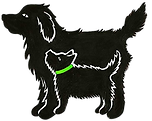Preparing your dog for Winter
- Pamela
- Nov 11, 2019
- 3 min read

Autumn is well and truly with us and now is the time for us to prepare our dogs for winter as the nights draw in. Just because our dogs have a fur coat doesn’t mean they are automatically set up for the colder months. Here are some pointers to help you.
Grooming
Brushing is essential to prevent knots and matts from forming. It’s important to remove the old coat and allow the air to flow freely through to the skin so that your dog can regulate his temperature.
Check the paws for snowballs, stones and mud between the pads. Trim the hair carefully under and around the paw to prevent ice build-up. Rinse and wipe paws from salt and grit after each walk, these harmful substances can irritate your dog’s paws.
Remove snowballs from their coat when you get back from a walk.
Central heating can dry your dog’s skin out. If your dog shows signs of dry skin, coconut oil is a natural moisturiser but remember a little goes a long way. You can also buy paw and nose balms to protect your dog.
Groomer’s get booked up early, so make sure you have an appointment in the diary to keep your dog’s coat in tip top condition.
Dog coats
It can help to keep your dog clean to reduce the daily maintenance. They come in all sizes and can cover the body, or a full suit will cover body and legs.
Dogs with a thin coat and puppies and veteran dogs will be kept warm and dry by an appropriate coat. To be effective it needs to go from the base of the neck to the top of the tail and cover the chest and belly.
A drying coat can be very useful to wick away moisture from the coat when you come back from a walk. Towel dry your dog first to remove the excess and then put the drying coat on for the recommended amount of time, then remove.
To ensure that you and your dog are visible to motorists and other passers-by in the dark, try a reflective coat with a reflective lead, and/or flashing collar.
Bedding
Keep your dog warm and out of draughts. Raised beds and extra bedding will keep him warm and snug. Some dogs like to burrow so extra blankets allow them to make a snug den.
Fireplaces, radiators & heaters
Make sure that your fireplace is safe and has a suitable guard to prevent your dog from getting too close to an open flame or heat source. If your dog loves the heat, make sure that your radiators or heaters are not going to burn your dog if they lie near or against them.
Hydration
It is just as important for your dog to have a water bowl filled with fresh water in the winter as it is in the summer. If your dog is wearing extra layers or the central heating is on, they will need to be kept hydrated.
Puppies, Older Dogs and Poorly Dogs
Take care that puppies don’t get cold when playing outside, keep an eye out in case they are shivering. Make sure that they don’t spend too much time in the cold and that they are supervised.
Arthritis can be more painful in the cold weather, if you suspect your dog is suffering speak to your vet.
Antifreeze & De-Icer
If you use antifreeze or De-Icer make sure that it is well out of the way of your dog as antifreeze is extremely toxic to dogs, a small amount can be fatal. If you suspect your dog has come into contact with these substances contact your vet immediately.
Hypothermia
It doesn’t matter how thick a dog’s coat is, they can all become susceptible to hypothermia if their body temperature drops too low. Young and geriatric dogs are at higher risk, as are dogs with very thin coats.
Signs to look out for if you think your dog might have hypothermia
Shivering
Pale gums
Low energy, weakness, lethargy or seeming sleepy
Stumbling into things, not very alert
Shallow breathing
Coma
If you think your dog has hypothermia, phone your vet immediately and take their advice.
You can also try these in the meantime
Get your dog out of the cold or find a dry sheltered spot out of draughts.
If your dog is wet gently towel them dry.
Keep them still and wrap them up in a blanket, coat, scarf or thermal wrap. Warm them slowly so as not to shock their body.
Offer them some lukewarm (not hot or freezing cold) water to drink.
Get them to the vet
NEVER LEAVE A DOG IN A COLD CAR – it can be as serious as leaving a dog in a car on a hot day!
Hopefully these top tips will help keep your dog snuggly safe and warm this winter.
























Comments